Monumental Miyazaki & More: The Movies of Studio Ghibli Ranked
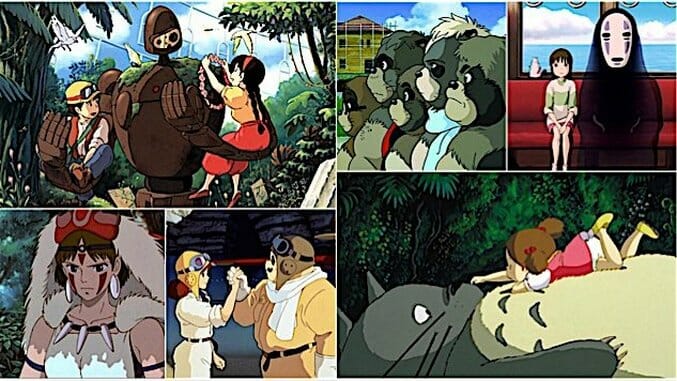
Dusk that colors the clouds every shade of peach. Light playing across clear, rushing water or dappled across a dirt road by the shadows of leaves. The invisible wind that caresses grass and leaf and hair. For Studio Ghibli films, these moments of ephemera heighten the world around the characters and reflect the complexity of their inner lives. The visuals will never quite match the soaring emotions the characters’ struggles and triumphs evoke, but damned if they don’t come close. In 32 years of animated films, there’s hardly a frame you’d hesitate to blow up and hang on your wall.
When he founded the studio in 1985, director Hayao Miyazaki and his collaborators named it for the Libyan term for “sirocco,” the hot Mediterranean wind—and, tellingly, as you’ll see, for an Italian flying machine. (A pronunciation note: Although both the Libyan Arabic and Italian term feature a hard “G,” the studio’s name is pronounced with a soft “G” in its native land.)
In addition to conquering the cinematic landscape of Japan, the studio has become celebrated around the world, including in the United States, where its partnership with Disney has ensured its movies get charming English localizations loaded with big-name actors. A far more important test—which nearly every film passes—is the only litmus test most parents care about: Plop your kiddos down in front of a Ghibli movie, and they will probably gaze goggle-eyed at it for the duration.
As Miyazaki comes out of retirement to work on another animated feature and the news spreads of a planned Ghibli theme park, now’s as good a time as any to rank all 20 of the studio’s feature length animated films.
(Another note: Though it is incredible, Nausicaa of the Valley of the Wind (1984) was actually made before the studio’s founding, so it narrowly misses this list. It’s widely available these days, and you should definitely check it out!)
20. Tales From Earthsea (2006)
Director: Goro Miyazaki
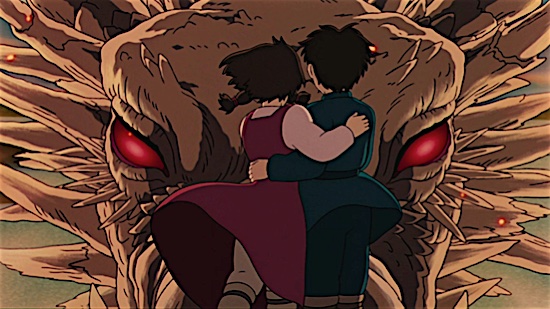
Adapted from parts of Ursula K. Le Guin’s fantasy series, Tales From Earthsea tells the story of young Prince Arren, who kills his father, steals an enchanted sword, and sets out into the world to discover why it is dying. Adapted mostly from the novel The Farthest Shore, it pulls in some characters and situations from other books.
Earthsea is widely regarded as one of Ghibli’s worst entries, so its low ranking here shouldn’t surprise anybody. It’s not an unfounded viewpoint—there are major problems here that go beyond the film being below the usual sky-high Ghibli standards. The animation, while technically competent, lacks the vividness of other entries. This is a story of dragons and wizards and magic swords, yet far more subdued fantasies in the Ghibli canon do far more to leap off the screen than this one does. The story is bafflingly incomplete. We have no idea why the hell Arren killed his father, what is causing the world to decay, and who the bad guy is. The ending comes out of nowhere, even by the standards of children’s fantasy. It’s an unfortunate stumble on the part of Goro Miyazaki (son of founder Hayao Miyazaki), and an unfortunate missed opportunity for an adaptation of a long-running, well-regarded fantasy series.
19. My Neighbors the Yamadas (1999)
Directed: Isao Takahata

There is some beauty in the petty squabbles and everyday silliness of a family. I want, desperately, to rank My Neighbors the Yamadas higher than this, but it’s just so very, very thin. The animation, modeled to resemble the bubbly and imperfect drawings of the toddler whose perspective guides us through the various slices of life that illustrate her family, doesn’t do enough to overcome its juvenile presentation.
There are some truly inspired sequences in this pleasant (and, I’m sorry, kind of boring) little movie—a mother-in-law’s wedding toast narrates a surreal trip through a literalized version of her metaphor-heavy speech, for instance. But, like many of the less challenging parts of the Ghibli catalog, the stakes here are too low to get you too excited, and there are way more interesting explorations of everyday life we’ll visit far higher in this list.
If you have any doubt that childhood is fundamentally the same odd experience in Japan as it is here in the States, though, this should dispel that doubt.
18 The Secret World of Arrietty (2010)
Director: Hiromasa Yonebayashi

The Clock family are little four-inch-tall people who live in the walls of a house occupied by a kindly family. They are Borrowers—who take only what they need. On the occasion of her coming-of-age, Arrietty, the family’s daughter, accidentally reveals herself to the house’s guest—a sickly boy. Together, they try to overcome the distance that separates them, and don’t quite succeed.
Arrietty feels like it ought to rank higher—the miniaturized world of the Clock’s home is delightfully animated and realized. It ranks this low because there just isn’t a lot going on here. It’s a slight adaptation of a slight children’s book series, much like Earthsea.
17. The Tale of the Princess Kaguya (2013)
Director: Isao Takahata

Based on a folktale, Kaguya is a story about a poor woodcutter and his wife, childless, who discover a perfect pixie of a girl concealed within a stalk of bamboo. She grows to young womanhood with unnerving speed, and her father decides that the gods have ordained she be a princess. But, as she is stifled by the strictures of court life, she begins to remember the celestial life she left behind to fall to Earth.
I ranked Kaguya so low because it really feels far longer than it ought to be. Much of it could have been achieved in a short film. The art style adopts a watercolor or woodblock print aesthetic—outside the Ghibli house style and a welcome departure from it. But the parts where the film shifts to impressionistic and dreamlike flights of fancy are too few and far between. I really wanted to like this one more.
16. Only Yesterday (1991)
Director: Isao Takahata
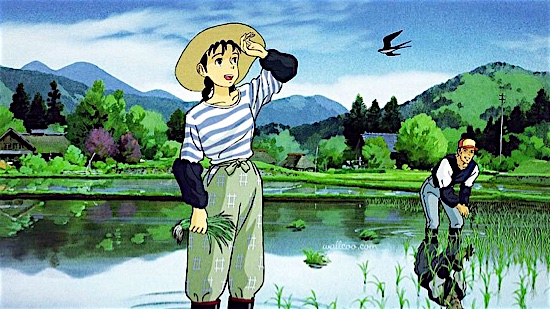
Given the chance, would you cast off your awkward, painful, embittering childhood? Any of us might. Only Yesterday gently argues that you shouldn’t and you probably can’t, even as it acknowledges all the reasons you’ll surely want to. It follows Taeko, a 27-year-old woman (who is for some reason drawn to look 40) who takes a short sabbatical from her boring office job in Tokyo to go board with a kindly rural family. (In a Ghibli film?! You don’t say.)
Not by any means a bad film, but a slight one. For me, a slice-of-life yarn is always going to lose out to animation that’s much more imaginative. Which isn’t to say this isn’t, either: The art is as luscious as some of the finest entries in the studio’s filmography. The childhood flashbacks feature some true beauty, with one scene of puppy love in particular framed as if it fades to white around the edges—like any half-remembered memory. There’s a lot of slice-of-life stuff about ’60s and ’80s Japan. It’s also filled with meditative scenes of real nature that transcend a lot of things you see in animated films. It ranks as low as it does here because I can’t really find many good reasons to argue that it shouldn’t have just been a live-action film. It’s well worth a watch, but not one the kids would find terribly entertaining.
15. Pom Poko (1994)
Director: Isao Takahata

Strap in, folks.
For background, Japanese folklore is replete with tales of animals with the ability to change shape. Foxes are obviously the most famous example, but another is the tanuki, called the raccoon dog in English. Pom Poko tells the story of a population of these winsome little mammals as they try to survive the real-life historical event of one of the Tokyo area’s largest residential developments utterly ravaging their environment. The sprawling cast of the tanuki community bands together to fight the encroaching humans. As their doomed resistance drags on, we watch them live, learn, love, play hilarious pranks on humans, and fight … with their nutsacks.
Tanukis are, apparently, mythologically well-endowed little creatures, capable of using their shapeshifting to turn their nuts into, at various points: An entire ship for sailing some of the doomed raccoon dogs off to Valhalla, hang-gliders for dive-bombing human military police, and boulder-sized bludgeons.
There is just so much plot ground to cover here, and it is all so delightfully weird. Far more important a content warning than the testicular battles, however, is the weird-as-hell tonal dissonance of this light-hearted woodland adventure taking a truly hopeless turn at the end.
14. The Cat Returns (2002)
Director: Hiroyuki Morita

Kids’ movies are simply loaded with smooth-talking cats, but I submit that Baron Humbert von Gikkingen might be the sleekest gato of them all. He is also the only principal character in a Ghibli film who has appeared in more than one feature, if you’re keeping track. Dapper, unflappable, and so effortlessly and non-threateningly macho that even a human teen goes to pieces over him, the Baron may not be the protagonist of The Cat Returns, but he’s certainly the hero.
The film follows the misadventures of struggling youngster Haru, a shy high schooler who saves a cat from getting run over by a car, only to discover that this kitty is in fact the Prince of Cats. His father the King and the various other mystical talking cats shower Haru with well-meaning if misguided gifts (such as a swarm of mice in her locker). When she tries to get them to knock it off, she discovers that the King’s gratitude is so broad that he has in fact betrothed her to his son. Horrified, Haru seeks help from the indefatigable Baron and his bumbling sidekicks.
The Cat Returns is too delightful to be this short, failing even to clock in at an hour and a half. The visuals are lush and inventive, Haru’s journey to the cat kingdom and the Baron’s trickery and swordplay are too much fun, but the movie sadly seems to miss some opportunities to give Haru any deeper personal growth. She doesn’t have a lot of agency in her own story, and her maturation by the end feels a lot less earned than many other protagonists in the films to come. I would’ve loved to place this charmer higher. You will nonetheless wonder what it takes to get the Baron in your corner when you find yourself fending off the advances of unwanted, hairy suitors.
13. Kiki’s Delivery Service (1989)
Director: Hayao Miyazaki
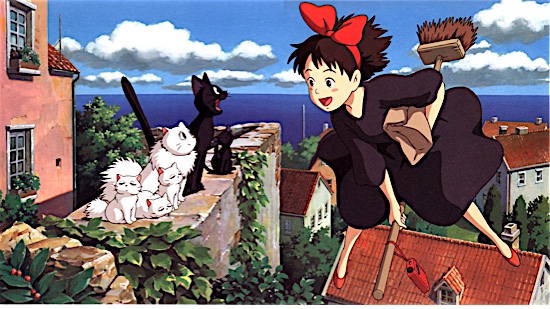
I just know I’ll get some outrage for putting this classic crowd-pleaser so low, but hear me out.
Kiki’s eponymous witch turns 13, the age at which practitioners of magic strike out on their own to find a place that needs a patron (matron?) witch. Unfortunately, the poor girl can barely steer her broom. As she sets up her fledgling delivery service, she experiences the ups and downs of adult responsibility and finds herself doubting her own abilities just when she needs them the most.
Kiki is a story about growing into the rough parts of young adulthood. Even toward the end of high school, I felt like my art just wasn’t as good as it was when I was younger—that I had lost some essential spark of blazing, chaotic creativity that I could never get back. Kiki struggles with that same ennui, that same crippling self-doubt. Getting over it is a triumph that overshadows any of the aerial feats in the film—soaring though they are. If it’s placed down this low, it’s only because that personal journey just doesn’t feel as big as some of the others we’re about to discuss.
12. When Marnie Was There (2014)
Director: Hiromasa Yonebayashi

How much can one really super weird detail ruin a great movie? Watch When Marnie Was There and you will answer the question for yourself.
Young Anna, an orphan living with a foster parent in Tokyo, suffers from severe asthma and is sent out to the boonies for some fresh air. She rooms with a kindly old rural family (fill out your bingo card!) and fails spectacularly to get along with the local children. But across the marsh is a beautiful, rambling old hotel, long abandoned, that lights up mysteriously in the night. And an otherworldly young blond girl there forms a deep, secret friendship with Anna. Her name is Marnie, and it soon becomes clear there is a lot more to her than there first appears to be.
Look, I’m just going to tell you, because I know a lot of people won’t dig this deep into Ghibli’s catalog and it’s just too good: The twist isn’t that Marnie is a ghost, since, come on, that’s obvious. The twist isn’t that Marnie and Anna’s friendship is a lot closer and a lot more intimate than you might expect in a kid’s film—seriously, I have watched tons of anime and it only means one thing when a young girl’s cheeks flush like Anna’s do in Marnie’s presence.
No, dear readers: The twist is that Marnie is the ghost of Anna’s dead grandmother who was having a secret lesbian ghost relationship with her own granddaughter. What the hell do you do with that one? The movie tries to play it like they were besties, but the directing, the art, the voices, all code it like a repressed lesbian relationship AND I’M NOT CRAZY, YOU ARE!
Anyway, other than that, it’s a great film. The landscape scenes were so beautiful that my girlfriend literally cried.
11. Whisper of the Heart (1995)
Director: Yoshifumi Kondo
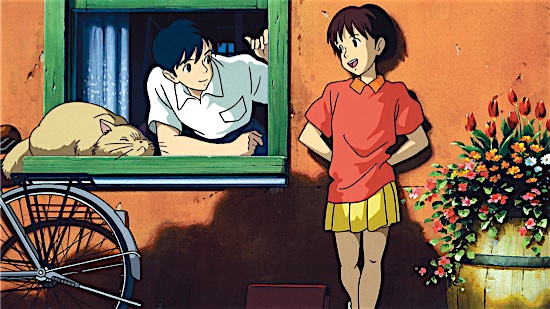
Fifteen years after blowing off more than a few classes so I could scribble weird fiction in a notebook, I can confidently say that if I had taken fewer of the subjects about which I gave not even an eighth of a shit in school, I would have suffered not at all. (Don’t tell any high school students, though! Society would collapse!) Whisper of the Heart understands how it feels when creative passion seizes the soul and demands an outlet, and also how terrifying and immobilizing is the accompanying dread all artists feel at the possibility they will never be equal to the inspiration flaming within their hearts.
It’s a deep tragedy that this is the only feature directed by Yoshifumi Kondo, who died a few years later at the age of 47, for it is a delightful oddball of a movie, and the first appearance of that smooth talker, the Baron. Opening and closing with covers of, no joke, “Country Roads” by John Denver, it follows Shizuku, a high schooler struggling with musical and writing aspirations. She discovers she’s been checking out the same library books—all of them—as another young man, Seiji. The two are drawn inexorably to one another, but separated by their doubts about their artistic ability—he, a violin-maker, she a budding writer trying to craft a story for the beautiful cat figurine known as the Baron that Seiji’s lonely grandfather keeps in his antique shop.
I loved how perfectly this movie understands Shizuku’s angst about her work, her obsession with it, and her utter disregard for the meaningless distractions of her mundane life that keep conspiring to steal time away from her work: Useless school, nagging parents, obnoxious siblings. Am I being harsh? It feels that way when you’re trying to pull something larger than yourself out of your head and show it to the world.
10. My Neighbor Totoro (1988)
Director: Hayao Miyazaki
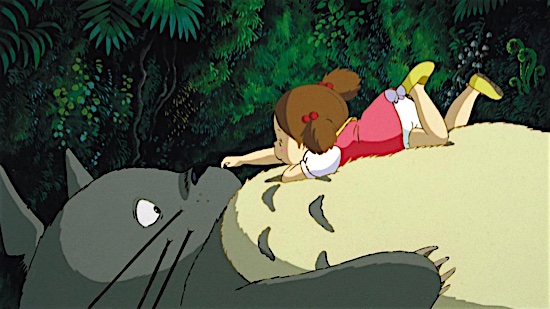
There’s a reason Totoro’s fuzzy mug has adorned every Ghibli project for nearly 30 years. This children’s tale is a testament to the kind of storytelling that the studio can display when it knows exactly how it wants to make its audience feel. Following two young sisters as they adapt to a new home while their father commutes long distances and their mother sits in a hospital, it gradually begins to introduce the elements of the fantastical in much the same way all your favorite British kids’ lit will do. Eventually, the girls meet and befriend Totoro, a large fluffy fellow with plenty of helpful woodland friends who are ready to aid the girls.
Lots of Ghibli films feel slight or low-stakes. Totoro does, too, and I was tempted to rank it lower until I watched it again, more closely than I had previously. It was the first time I’d seen it since my brother had his two daughters. It finally dawned on me, oaf that I am, that I’ve rarely ever seen another movie that understands what it’s like to be a toddler. It’s a vitally important thing to remember what that’s like.
9. Castle in the Sky (1986)
Director: Hayao Miyazaki
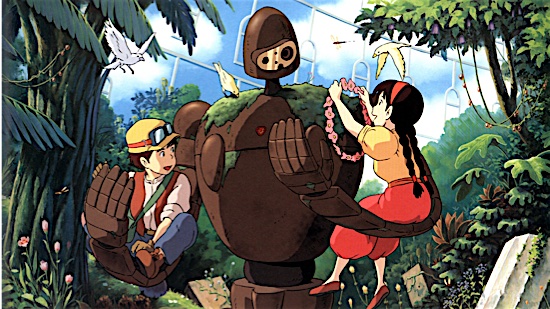
Ghibli’s maiden voyage into the boundless dreamscape it’s been guiding viewers through features a lot of the things the studio would come to be known for as it racked up success after success. Miyazaki is at his most daring and wistful when you give him flying machines to play with, and Castle is one of his most imaginative adventures. Set in a world of fantastical airships, air piracy, and steampunk splendor, it follows the journey of a young girl in possession of a mystical necklace. Teaming up with a young orphan boy who also believes in the tale of an ancient castle that floats through the air. Together, they are in a race against the pirates, the army, and the government spooks who want to steal the power of that ancient kingdom for themselves.
A lot of the themes of Ghibli are at play here: Flight as a metaphor for freedom, the corruption inherent in any situation where man’s hubris leads him to destroy his environment. Most importantly, there’s enough wizardry and wonder, enough inventive art design and soaring visuals for a whole 10-season TV show. This one is a can’t-miss for anybody who loves a good adventure story.
8. Grave of the Fireflies (1988)
Director: Isao Takahata
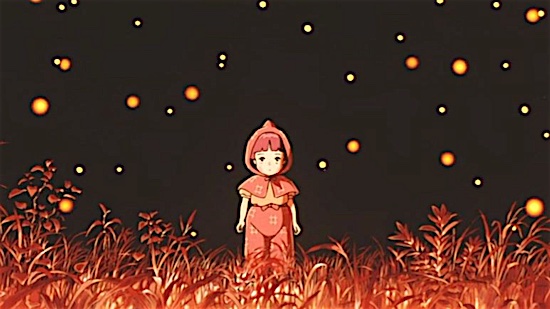
Did I say “low-stakes” earlier?
Grave of the Fireflies is a must-watch if you want to see a real, on-the-ground story of the true fallout of war. It is also the absolute most depressing and deflating film in Ghibli’s 30-plus year portfolio. The story follows the tenuous lives of a boy and his younger sister as they struggle for survival in a Japan destroyed by the Second World War. They find what joys they can in a time when food is scarce and adults are straight-facedly insane.
This was the dark release that showed Ghibli wasn’t just about giggly fun like Totoro. It dares to ask how a fragile light can burn in the face of a boundless and soulless dark. Unfortunately, it also dares to answer that question. I’ll close with a quote from my own father: “Fuck you for making me watch that movie.”
7. Porco Rosso (1992)
Director: Hayao Miyazaki
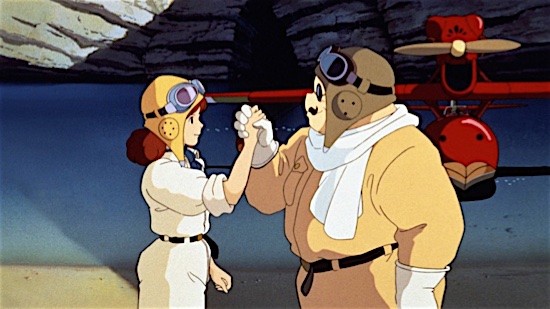
Ghibli films are chock full of dragons, swordsmen, witches, and enough plucky young girls to fill up a whole YA section at your local library, but I submit that Porco Rosso is far and away the baddest hero the studio has yet drawn to life. This swanky movie drops us into the Adriatic Sea during the rise of Fascism, rewriting history to make it a wretched hive of scum and villainy and air piracy that provides a blanket excuse for thrilling dogfights (yet never the horror of bodies being shredded by anti-aircraft guns). The film also comes with a fuselage fairly stuffed with lines that would sound at home in Casablanca.
The surly pilot envied by all the rough types in the Adriatic is Porco Rosso, the Crimson Pig—an Italian pilot cursed with the visage of a pig for his desertion of his post. This transformation is never depicted, nor explained, and you won’t care. Porco has a swagger unseen since Bogart. He’s unflappable, unkillable, and as unswervingly good and true as he is disdainful of the pomp, preening and pretense that his enemies display.
Porco Rosso is about grappling with guilt, inadequacy and the crippling feeling that you’re a bad person who is unworthy of love. God knows I’ve felt that way before. I immediately recognized Porco’s reflexive self-deprecation in nearly every scene: Hey, what do you want from me, I’m just a pig.
The people who love him know better.
6. Ponyo (2008)
Director Hayao Miyazaki

It often feels like fate drags us apart, or that we need to make ourselves into someone else in order to be with somebody. But isn’t it always because of outside forces—things that shouldn’t affect us and yet won’t let us be? Miyazaki’s take on “The Little Mermaid” writes some of those themes a bit smaller for the younger viewer, but makes up for it with some of the most incredible and awe-inspiring visuals the studio has ever produced. When the king of the sea isn’t looking, his most precocious daughter decides to slip the leash and go explore the surface world, where she meets and falls into sincere puppy love with the boy Sosuke. Adopting the surface name “Ponyo,” she accidentally unleashes world-shaking magical calamity during her second escape attempt, and finds that her sweet efforts to live among the humans could come at a huge price.
This is a tale of storms, monsters, gods, and the freaking moon threatening to crash into the Earth. It’s also a tale of two plucky youngsters with massive hearts. This pairing of the epic and the intimate has only ever been so masterfully portrayed a very few times by Ghibli. This one ranks so high because in addition to that pitch-perfect tone, Ponyo is one of the best-looking features Ghibli has ever produced.
5. From Up On Poppy Hill (2011)
Director Goro Miyazaki

Yes, this sweet tale of tween love is in the Top Five. Sue me. Poppy Hill is the only filmic evidence I have yet seen to support the assertion that somebody could ever feel nostalgic for a time during which they never lived. Goro Miyazaki hits this tale of young love and the conflict between tradition and progress out of the park. Set in Yokohama in the year leading up to the 1964 Tokyo Olympics, it follows high school girl Umi, still mourning the father taken from her by the Korean War. She falls in—and falls in love with—Shun, a politically active young classmate leading the drumbeat to protect an old school clubhouse from demolition to make way for more Olympic facilities. As the two find the strength to fight for their ideals, they struggle with the possibility that their love could be forbidden.
Poppy Hill’s visuals, its swinging score, its animation of bustling crowds and old-timey public transit and sparkling water and delicious food, and its moments of tense stillness all put you back in 1963 and, more than likely, your own memories of summer lovin’ in Japan that you have now even though they didn’t happen to you. I do not like this kind of movie at all, yet it hooked me from the first few minutes straight through to the end. If you don’t cheer at the end credits of this one, go see a cardiologist—your heart may have been stolen by a misunderstood witch.
4. Princess Mononoke (1997)
Director Hayao Miyazaki
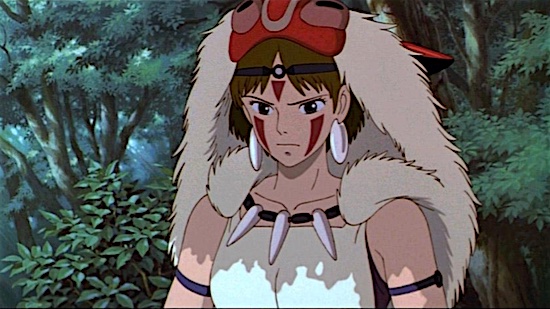
I promise this high ranking for Mononoke is not merely because it was my first experience with Hayao Miyazaki and Studio Ghibli in a theater in the States. It really is as awesome as your enthusiastic anime friends say it is. There are scenes in this film that have seared themselves so deeply in my memory that I’ve found myself seeking it out for a re-watch regularly over the years.
The story follows Ashitaka, young prince of a hidden tribe (the Emishi people—a real tribe that really did resist the rule of the earliest Japanese emperors, if you’re interested). Wounded in a deadly battle with a rampaging forest god, Ashitaka discovers he is cursed to die unless he can discover what infected the mad god with rage and put a stop to it. (The curse might be slowly eating his body alive, but it also gives his arm absurd, limb-amputating, sword-breaking strength in the meantime. Every cloud…)
Ashitaka traces the dead god’s path of destruction back to Iron Town, a massive foundry where the Lady Eboshi protects and nurtures women and lepers and also carries out a war of attrition against the gods and spirits of the forest in a quest to dominate the wild. Her most bitter nemesis is the girl San, a human raised by wolves, known as Princess Mononoke to the locals. There aren’t really “bad guys” in a Ghibli film, only those who act in misguided ways. No other film positions that ethos as central a theme as Mononoke does.
As one of the most eye-popping features the studio has ever made, with its strong environmentalist and anti-war messages front and center and a whole forest full of peculiar creatures, you could do worse for an introduction to the Studio Ghibli style than this epic yarn.
3. Howl’s Moving Castle (2004)
Director: Hayao Miyazaki

My top three are among the more recent Ghibli features for the simple reason that the studio has only gotten better at realizing its visions over its three decades. Howl features fantastical imagery throughout, imagining a magical steampunk world of wizards, flying machines, shapeshifters and petty enchantresses that feels even grander and deeper than the little slice of it we get to see. A prim and proper young haberdasher, Sophie, runs afoul of a handsome young magician who takes her on a brief, magical chase through her Victorian-themed home city after saving her from some loutish soldiers. Unfortunately, her friendship with the mysterious wizard Howl catches the eye of the jealous Witch of the Waste, who slaps a curse on Sophie that gives her the appearance of a 90-year-old woman and the most frustrating of Non-Disclosure Agreements.
Falling in with Howl at his magical, mechanical moving castle, Sophie tries to help the mercurial wizard as he runs from the authorities—who want him to turn his incredible magical talent into weapons of mass destruction in a pointless war.
Ghibli trades in the language and tropes of folklore with cheeky deftness in this feature. Curses must be broken with true love, the humble ones are never quite whom they appear to be, and the simplest acts of kindness and loyalty pay big dividends. It also remains grounded in a story about finding one’s true self and having the courage to face down responsibility. It’s visually astonishing, avowedly adventurous, and the kids will love it.
2. The Wind Rises (2013)
Director: Hayao Miyazaki

“The wind is rising. We must try to live,” goes the refrain of this solemn meditation on the power of dreams and the inexorable tides of history that drag us away from realizing them. Adapting elements of real-life aeronautical engineer Jiro Horikoshi—designer of the Japanese Zero fighter, the Imperial Navy’s chief fighter during the Second World War—this story also draws in characters and situations from other novels set in the years surrounding the Great Earthquake and the war.
Tellingly, it was also supposed to be Miyazaki’s last feature film; he has recently announced he’ll return for a future endeavor. Had it been, it would’ve been a sendoff worthy of film history. Few films indeed have ever so evocatively depicted the terrifying sweep of history. It is also, incidentally, loaded with the idiosyncratic marks of a Hayao Miyazaki feature—including the endearingly specific dream world where Jiro converses with an Italian aeronaut and sees his turn-of-the-century flying machines come to magical life.
The film follows Jiro, a hopelessly nearsighted young airplane enthusiast as he witnesses the earthquake that ravaged Japan. He stumbles through his humble work, wishing to once again encounter the beautiful young woman he met during the cataclysm. And when they are finally reunited again, he finds her clinging desperately to life in an ultimately losing battle with tuberculosis.
In the meantime, though, Jiro dreams of the flying machines he wants to create and perfect. The wind that sweeps him up in creative fervor is the same that lifts his inventions into the air, and the same that pulls him helplessly along in a world determined to separate him from his love and use his talents to make war.
History is decided by powerful forces that are not kind, and it doesn’t always get better, Miyazaki says. But we must try to live.
1. Spirited Away (2001)
Director: Hayao Miyazaki

There is something about the very oldest stories that stick with you millennia after the first time storytellers spun them from the air. That folkloric, mythical, legendary quality suffuses my pick for the very best Studio Ghibli has to offer. Spirited Away tells the story of Chihiro, a willful little brat whose dimwitted parents pause in their cross-country move to go bumbling about an abandoned theme park, over her protests. The fact the place is abandoned and creepy doesn’t stop them from immediately chowing down on some alluring food which promptly turns them into pigs, because of course it does haven’t you ever heard this kind of story?! Grown-ups, am I right?
Nutting up and demanding her parents’ release, Chihiro sells her name and her labor to the witch Yubaba, the wily mistress of the theme park. At night, the place transforms into a luxury spa for visitors from the spirit world, and Chihiro must make her own way as a lowly servant there if she’s to break the curse on her porcine parental figures and return to the real world. Aiding her are the enslaved river dragon Haku and a cast of (mostly…) good-hearted bumbling sidekicks.
Spirited Away is an imaginative, incomparably gorgeous fable filled with memorable moments, bat-shit crazy creature design, hilarious high adventure, and tons of feelings. Many of the other entries on this list end with a gut-punch or an abrupt (if triumphant) ending. Spirited Away’s denouement will leave you satisfied like few kids’ movies today. It remains Miyazaki and Studio Ghibli’s most vividly realized dream.
Kenneth Lowe isn’t a monster, he’s just misunderstood. His writing has also appeared in Colombia Reports, the St. Louis Post-Dispatch and Illinois Issues Magazine. You can read more of his writing at his blog.